| Roger Reini's Bahá'í Pilgrimage Journal | ||
| First Attempt Prelude to Departure Departure for the Holy Land Day 1 Day 2 Day 3 Day 4 Day 5 Day 6 Day 7 Day 8 Day 9 Return Home Pilgrimage Home Page |
Day 4 December 27, 2007 Not having an early day at the PRC, I could take my time getting up. I woke up at 6:40, got dressed, then went down to the breakfast buffet. Delicious, as always. Around 9, I walked down the Louis Promenade toward the top of the Terraces. I think I saw a school group of young children en route. At the Terraces, the guard asked if I was going to the Shrine or the PRC. I said PRC, so he let me pass. I surmise I would not have direct access to the Shrine from the Terraces. As I walked down, I was in a contemplative mood, which befit my surroundings. I stopped at several of the terraces on the way down for thoughts, meditation and picture-taking. At one point, I had in mind my brother-in-law Randy, who was away from his family on an extended duty assignment; I prayed for him to be protected. 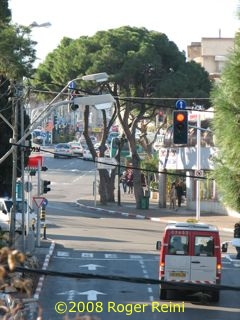 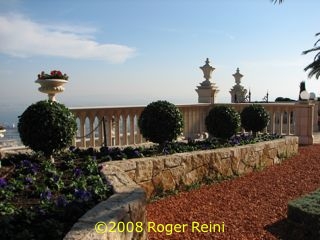 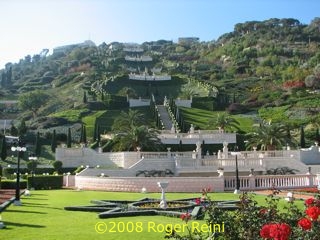 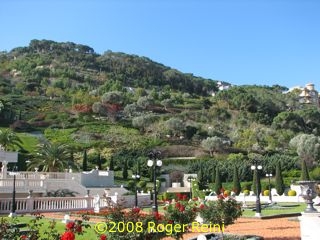 When I reached the PRC, I made a pit stop, then requested a key fob for the Monument Gardens, which were located just across the street. Buried here were Bahá’u’lláh’s first wife Navváb; His younger son by her, Mirza Mihdi; and His daughter by her, Bahiyyih Khanúm, the Greatest Holy Leaf. The monuments and the gardens were stately and, like all of the other holy sites, promoted reflection and prayerful contemplation. I reflected on their lives as I went through the gardens. At times, I could see the bus stop across the street; there were several soldiers there awaiting transport. 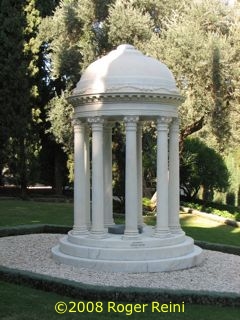 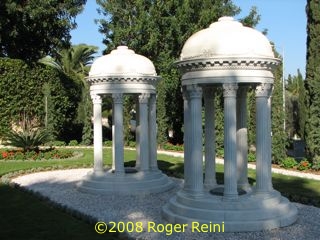 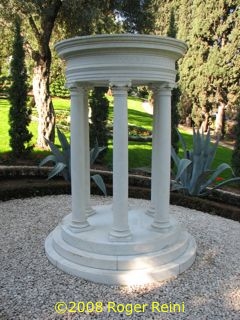 Back at the PRC, I cooled down for a while until our group’s bus was ready to leave. I met a late-arriving pilgrim from the Timmins, Ontario area; he’d been stuck in Toronto by heavy snow (or was the snow in Timmins?) and had only arrived today. He was trying to find the Tel Aviv airport on the map on the bulletin board. While writing some notes, I heard someone ask if I was from Detroit, It was Naseem Alizadeh, daughter of Hormuz and Azar. We could hold a couple of good presentations or firesides at the Detroit Center! 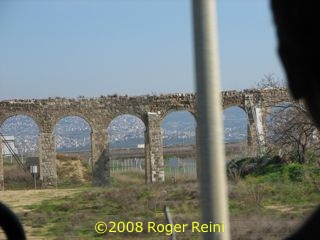 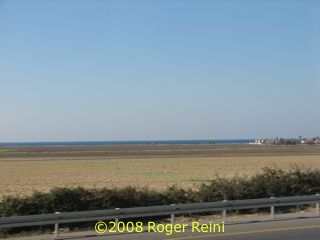 At 11:30, our bus set off for Bahjí. Just east of town, the bus followed a different route than the last few days, possibly to keep us from arriving too early. As it was, we did arrive at Mazraih (we went there first) a few minutes early. This was where Bahá’u’lláh lived for two years after He left ‘Akká. The grounds contained two large cypress trees that date from the era of the Blessed Beauty, and they also had many fruit trees -- mostly orange trees, though there was at least one grapefruit tree. Our guide Furio explained that a believer who was married to a British army officer had bought or rented the property, thereby preserving it for the believers. The building was not completely original; a room had been added, enclosing the staircase that went up. 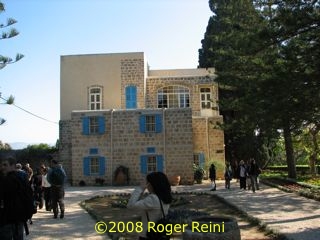 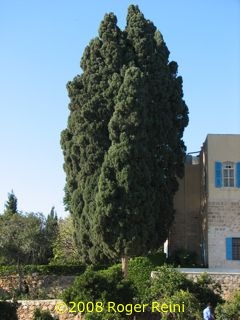 Inside, we removed our shoes and left our belongings (as we did when entering every holy place), then entered one of the rooms where the Blessed Beauty had revealed sacred verses (it was His reception room). We listened as one of us read an account by an early believer, Haji Mirza Haydar Alí, who was privileged to be in attendance during one such revelation. Then we went up the stairs, the original stairs. They were worn, and they were HARD! But the Blessed Beauty had walked these stairs. We were, quite literally, walking where He had walked. 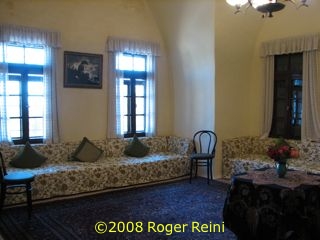 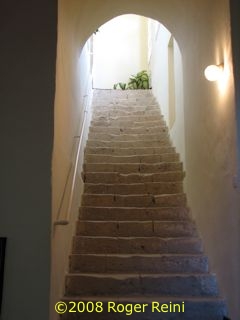 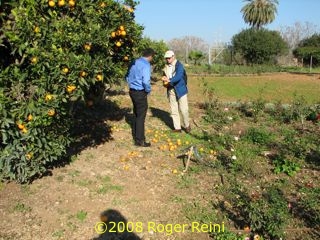  When we left the building, we had time to walk the grounds and take some pictures. If we wished, we could take any fruit that had fallen to the ground (we could not pick from the tree, though). Then it was time to take the bus to Bahjí. Here is where Bahá’u’lláh spent the last 13 years of His life. It was a magnificent structure, both outside and in. As we climbed up the stairs, there was a picture of the former caretaker of the Shrines of Bahá’u’lláh and the Báb. The Guardian had placed it at the top of the stairs so that he (Abu-Qassim, the caretaker) could always greet the pilgrims. We gathered in what we later learned was the bedroom used by the Guardian whenever he was in residence, working on building restoration or development of the grounds. It was filled with pictures and memorabilia of the progress of the Faith. This was where and when I read the passage from Professor Browne: ... my conductor paused for a moment while I removed my shoes. Then, with a quick movement of the hand, he withdrew, and, as I passed, replaced the curtain; and I found myself in a large apartment, along the upper end of which ran a low divan, while on the side opposite to the door were placed two or three chairs. Though I dimly suspected whither I was going and whom I was to behold (for no distinct intimation had been given to me), a second or two elapsed ere, with a throb of wonder and awe, I became definitely conscious that the room was not untenanted. In the corner where the divan met the wall sat a wondrous and venerable figure, crowned with a felt head-dress of the kind called taj by dervishes (but of unusual height and make), round the base of which was wound a small white turban. The face of him on whom I gazed I can never forget, though I cannot describe it. Those piercing eyes seemed to read one's very soul; power and authority sat on that ample brow; while the deep lines on the forehead and face implied an age which the jet-black hair and beard flowing down in indistinguishable luxuriance almost to the waist seemed to belie. No need to ask in whose presence I stood, as I bowed myself before one who is the object of a devotion and love which kings might envy and emperors sigh for in vain! A mild dignified voice bade me be seated, and then continued:—"Praise be to God that thou has attained! ... Thou has come to see a prisoner and an exile. ... We desire but the good of the world and happiness of the nations; yet they deem us a stirrer up of strife and sedition worthy of bondage and banishment. ... That all nations should become one in faith and all men as brothers; that the bonds of affection and unity between the sons of men should be strengthened; that diversity of religion should cease, and differences of race be annulled— what harm is there in this? ... Yet so it shall be; these fruitless strifes, these ruinous wars shall pass away, and the `Most Great Peace' shall come. ... Do not you in Europe need this also? Is not this that which Christ foretold? ... Yet do we see your kings and rulers lavishing their treasures more freely on means for the destruction of the human race than on that which would conduce to the happiness of mankind. ... These strifes and this bloodshed and discord must cease, and all men be as one kindred and one family. ... Let not a man glory in this, that he loves his country; let him rather glory in this, that he loves his kind. ..." Such, so far as I can recall them, were the words which, besides many others, I heard from Beha. Let those who read them consider well with themselves whether such doctrines merit death and bonds, and whether the world is more likely gain or lose by their diffusion.—Introduction to A Traveller's Narrative (Episode of the Bab), pp. xxxix-xl. It was then made even more profound to me when I followed in the professor’s footsteps and entered Bahá’u’lláh’s room. It was furnished as it was in His day. I saw His bed, His dresser and nightstand, the divan where He used to sit, two couches to the right. Beside His bed (a mattress on the floor, really) were a pair of His slippers (covered with a veil). On the divan was His táj or fez-like hat, placed where He used to sit. Those who entered prayed, meditated and contemplated. Some prostrated themselves; others knelt (I knelt in front of His táj). I could not help but compare His shoe size to mine; my feet were bigger. Undoubtedly, I am larger physically than He was, but spiritually, He towers over us all. 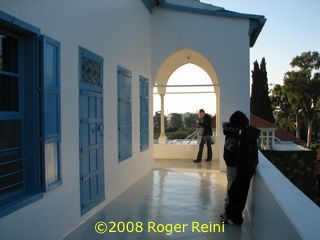 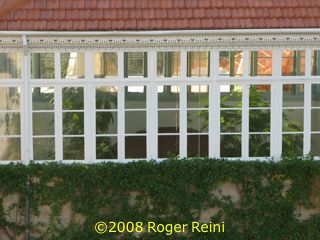 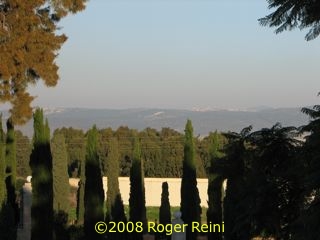 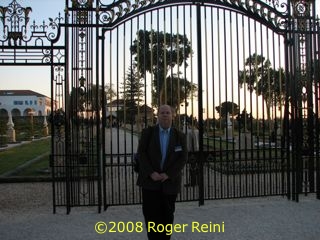 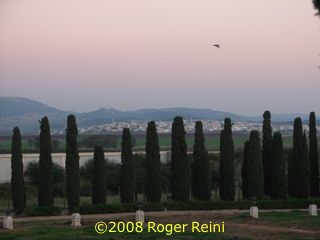 Our formal tour ended, and I found myself heading back to the visitor center with Ruth Hall and Hugh Smiley. As we neared the center, a guard stopped Hugh. Where was your pilgrim badge, asked the guard. It turned out that he had left it in another jacket back at his hotel. I was willing to vouch for him, but the guard called back to the central office and verified Hugh’s pilgrim status. The woven cap that Hugh was wearing didn’t help matters; it looked like an oversized yarmulke. But everything was straightened out. At the Visitor Center, I used the restroom, got some refreshments, then stamped my prayer book with the stamp for the Mansion of Bahjí. I then said my obligatory prayer, and then I went back to the Haram-i-Aqdas for some picture taking while there was still light. On top of some terraces, I could see where new sections of the gardens were in early stages of development. 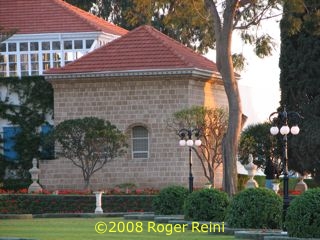 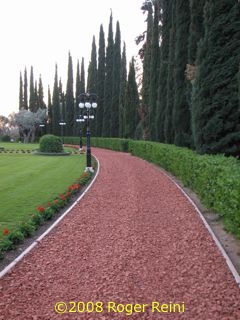 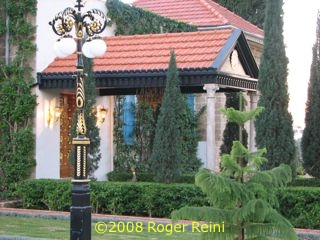 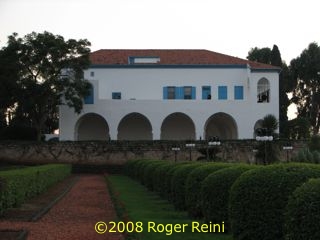 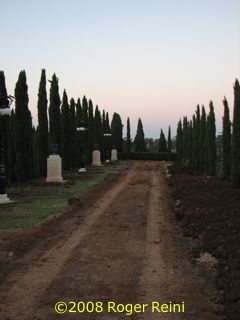 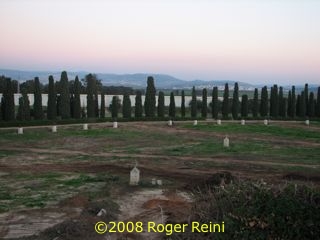 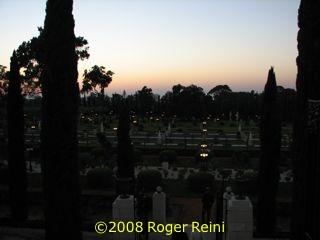 As the light of the sun faded, I proceeded to the Shrine for illumination by the Sun of Truth. I lined up for the opportunity to bow at the Sacred Threshold. This time I could see inside; candles and lights surrounded the spot where His remains lay (the candles were not lit). I bowed down and thought of my loved ones, then retired to the side room just to the right of the Threshold for longer-term praying the meditating. I went through the prayer list again, at one point reciting (silently, of course) the Long Healing Prayer. I spent a bit over an hour at the Shrine, and then I tacked away from the Threshold (tacking let me see to some extent where I was going). I was able to catch the 6:30 bus back to Haifa, where I had a good talk with an Angelino who had served here as a security guard (here meaning the World Center, not specifically Bahjí). He had been privileged to give a VIP tour to Benjamin Netanyahu and his family. Normally, there are special guides to do this, but this was the Jewish Sabbath, and no such tours were expected. He pointed out the lights of the Terraces from ‘Akká and said that it was possible for a light at Bahjí to be seen at the Terraces. For dinner, I ate at the nearby Dante Italian restaurant. The salad was good, and so was the linguini with meatballs. I was full when I left. Two of the Kelly family were dining as I left; this was their second time there. Back at the hotel, I turned on the news. To my shock, I heard that Benazir Bhutto had been assassinated a few hours earlier. I watched Sky News and Fox News for the latest developments. I said a prayer for her soul. Next: Day 5 Back: Day 3 Up: Pilgrimage Home Page DISCLAIMER: this is not an official page of any Bahá'í Institution. All comments are my own and derive from my personal understanding of the Bahá'í Teachings. For official information about the Bahá'í Faith, you may wish to visit www.bahai.org or www.bahai.us. Text ©2008 Roger W. Reini. Photos ©2008 Roger W. Reini except where noted. Photos marked "© Bahá'í International Community" are reproduced with permission of the Bahá'í International Community (http://media.bahai.org/). Written
by Roger Reini |
|